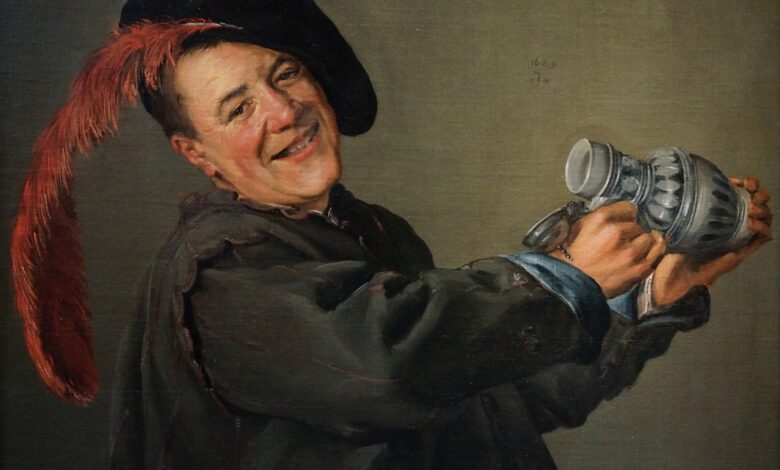
Judith Leyster, a prominent Dutch Golden Age artist, remains a captivating figure in art history, particularly for her contributions to Baroque painting and her status as one of the few successful women artists of her time. “The Last Drop,” a work that exemplifies Leyster’s mastery of genre painting, provides an intriguing subject for visual analysis. This essay aims to delve into the key elements of Leyster’s painting, exploring its symbolism, composition, lighting, color palette, and emotional resonance within the broader context of her life and the Dutch Golden Age.
Judith Leyster and the Dutch Golden Age:
Before delving into the specifics of “The Last Drop,” it is essential to understand the artist and the historical period in which she thrived. Born in Haarlem in 1609, Leyster began her artistic career at a young age, training under Frans Hals. Notably, Leyster was one of the few women artists active in the Dutch Republic during the 17th century, challenging gender norms and establishing herself as a respected painter.
The Dutch Golden Age, characterized by flourishing economic, scientific, and cultural developments, provided a fertile ground for artists like Leyster. Genre painting, a style that depicted scenes from everyday life, became immensely popular during this period. Leyster’s ability to navigate and excel in this genre attests to her artistic prowess.
“The Last Drop” – Symbolism and Narrative:
“The Last Drop” is a poignant example of Leyster’s proficiency in genre painting. The composition centers around a merry group engaged in revelry, their attention drawn to a young woman holding a pitcher. A sense of anticipation and camaraderie permeates the scene, capturing a moment of conviviality. The title, “The Last Drop,” suggests a culmination, perhaps marking the end of a celebration or the climax of a shared experience.
Leyster employs subtle symbolism to enrich the narrative. The focal point, the woman with the pitcher, becomes a symbol of abundance and hospitality. The act of pouring the last drop not only signifies the conclusion of a joyful event but also hints at the fleeting nature of such moments. The empty vessel may also allude to the transience of pleasure, inviting viewers to contemplate the temporal nature of happiness.
Composition and Chiaroscuro:
Leyster’s adept use of composition enhances the visual impact of “The Last Drop.” The figures are arranged in a dynamic yet balanced manner, guiding the viewer’s gaze through the scene. The triangular composition, formed by the characters, directs attention towards the central action—the pouring of the last drop.
Chiaroscuro, a hallmark of Baroque painting, is skillfully employed by Leyster to create a dramatic play of light and shadow. The contrast between light and dark areas accentuates the contours of the figures, adding depth and dimension to the composition. The subtle chiaroscuro also contributes to the overall mood, emphasizing the warmth of the illuminated faces against the shadowy background.
Color Palette and Emotional Resonance:
Leyster’s choice of color palette in “The Last Drop” is noteworthy for its vibrancy and emotive quality. Warm tones dominate the scene, with rich reds, golden yellows, and earthy browns creating a sense of warmth and conviviality. These colors not only evoke a festive atmosphere but also contribute to the emotional resonance of the painting.
The faces of the characters are rendered with expressive brushstrokes, capturing a range of emotions from joy to contemplation. The artist’s ability to convey nuanced expressions adds a human touch to the scene, inviting viewers to empathize with the depicted characters. Through color and emotion, Leyster transforms a seemingly ordinary moment into a powerful representation of shared experiences and the complexities of human connection.
Cultural Context and Women Artists in the Dutch Golden Age:
Understanding Leyster’s achievements becomes even more significant when placed in the context of the societal norms and challenges faced by women artists during the Dutch Golden Age. Women in the 17th century were often excluded from formal artistic education and guild memberships, making Leyster’s success all the more remarkable. Her ability to navigate this male-dominated field and establish herself as a respected artist reflects not only her talent but also her determination and resilience.
Conclusion:
Judith Leyster’s “The Last Drop” stands as a testament to the artist’s skill in capturing the nuances of human interaction and emotion within the vibrant tapestry of Dutch Golden Age genre painting. Through her adept use of symbolism, composition, lighting, color, and emotion, Leyster elevates a seemingly ordinary scene into a timeless exploration of the human experience. Beyond its artistic merits, the painting also invites contemplation on the cultural context of women artists in the 17th century, showcasing Leyster as a trailblazer who defied conventions and left an indelible mark on art history.



